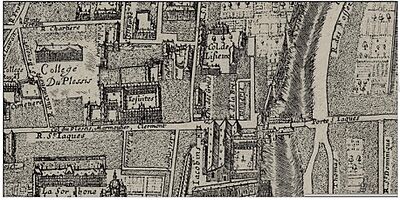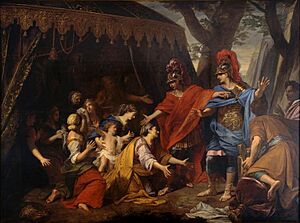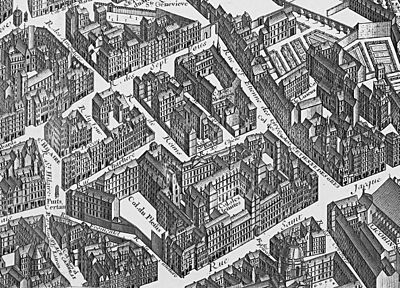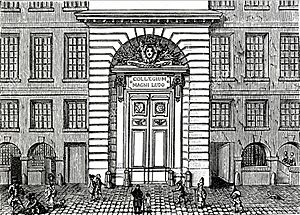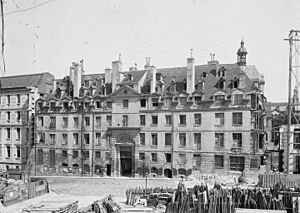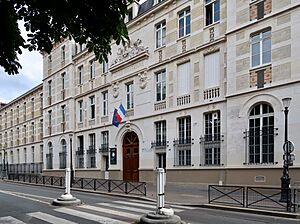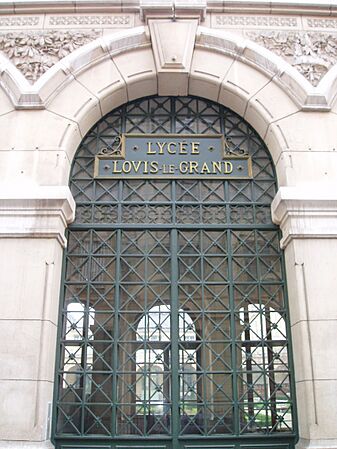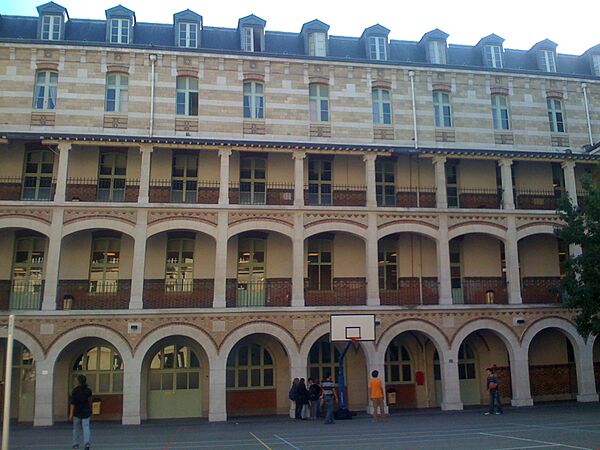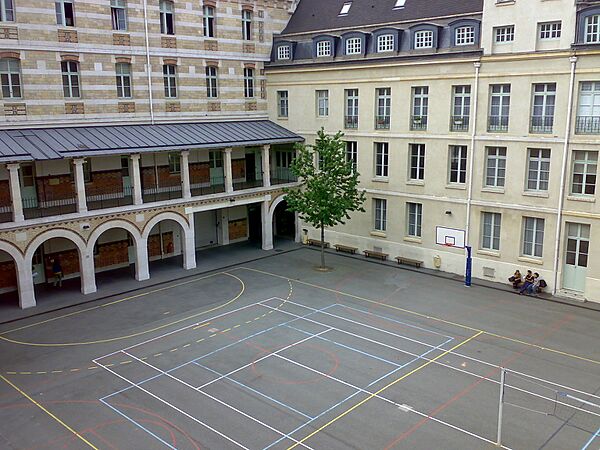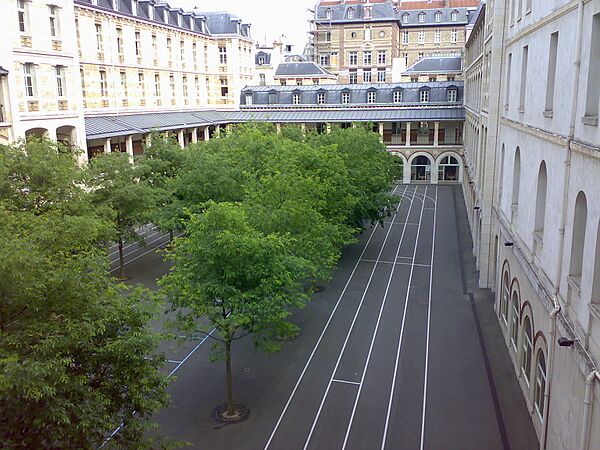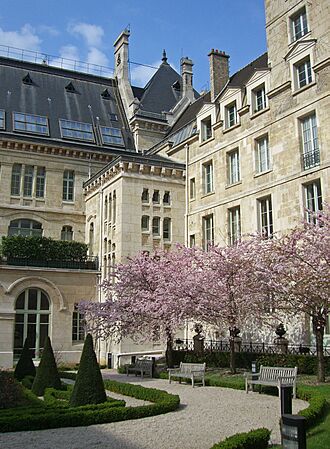Lycée Louis-le-Grand facts for kids
The Lycée Louis-le-Grand (pronounced "lee-say loo-ee luh grahn") is a famous public school in central Paris, France. People often call it simply Louis-le-Grand or LLG. It is located on rue Saint-Jacques.
This school was started in the early 1560s by a group called the Jesuits. It was first known as the Collège de Clermont. In 1682, it was renamed after King Louis XIV, who was also called "Louis the Great." Even after the Jesuits left in 1762, the school has remained one of France's top secondary schools. It offers both high school classes and special advanced classes called "Classes Préparatoires." These advanced classes help students get into top universities for science, business, and humanities.
Contents
Where is Louis-le-Grand Located?
Louis-le-Grand is in the middle of the Quartier Latin in Paris. This area has been a student district for hundreds of years. Many other important schools are nearby. The Sorbonne is to its west. The Collège de France is to its north. The Panthéon campus of Paris 2 Panthéon-Assas University is to its south. The Sainte-Geneviève Library is also close by.
A Look at Louis-le-Grand's History
The Jesuit College Years (1560–1762)
Jesuit students first came to Paris in the 1540s. In 1550, Guillaume Duprat, a bishop, invited them to stay in his home. This home became the Jesuits' first permanent place in Paris.
When Bishop Duprat passed away in 1560, he left money for a new Jesuit college in Paris. The Jesuits wanted it to be "the most celebrated college." However, there were delays because other groups in Paris did not want the Jesuits to open a school. In 1563, the Jesuits finally bought land on rue Saint-Jacques. They started teaching there in late 1563. The new school was named Collège de Clermont. This was to honor Bishop Duprat's help.
The college quickly became very popular. It was free and offered excellent education. This was different from other schools at the time. Its theology course, taught by Juan Maldonado, was so popular that the buildings were too small for all the students.
The University of Paris did not like the Jesuits from the start. They tried to stop the college from being recognized. But the Jesuits continued to teach and grow. By the 1580s, thousands of students attended the college. Hundreds of them lived there.
The college stayed open during the Siege of Paris in 1590. In 1594, a former student tried to harm King Henry IV. Because of this, the king expelled the Jesuits from France. The college building was used as a royal library for a few years. In 1603, Henry IV allowed the Jesuits to return. They got their college building back in 1606 and fully restarted teaching in 1610. After some more legal challenges, they were allowed to teach for good in 1618.
The college quickly became successful again. It received support from the French kings and important families. King Louis XIII visited in 1625. King Louis XIV visited in 1674. During his visit, Louis XIV gave the school a painting by Jean Jouvenet. This painting, Alexander and the family of Darius, is still in the principal's office today.
Many famous scholars taught at the college. These included the mathematician Pierre Bourdin and the historian Philippe Labbe. The college library had about 40,000 books by 1718. The Jesuits also built an observatory in 1660. In 1679, they created detailed sundials on the building, which you can still see today.
The college expanded its buildings over the years. In 1682, King Louis XIV officially allowed the college to change its name to Collège Louis-le-Grand. This showed that the king supported the school. A black marble sign with the new name was placed on the building.
In 1700, Louis-le-Grand took over a school for foreign languages. This was because the Jesuits were good at studying other languages and cultures. Antoine Galland, who first translated One Thousand and One Nights into a European language, studied and taught Arabic here. In 1742, the college even had five Chinese students.
After 1762: A New Era for the College
In 1762, the Jesuits were ordered to stop teaching in France. Louis-le-Grand became a national school and was renamed Collège royal Louis-le-Grand. Teachers from other schools took over. Students from many smaller colleges in Paris were invited to study at Louis-le-Grand. This made Louis-le-Grand the main center of the University of Paris.
During the French Revolution, the college changed its name many times. It was called Collège Égalité, Prytanée français, and Lycée de Paris. In 1805, it became Lycée impérial. In 1814, it was renamed Lycée Louis-le-Grand again. It has kept this name since 1873.
Louis-le-Grand was the only school in Paris that stayed open during the difficult 1790s. Parts of the building were used for soldiers or as a prison. In the 19th century, Louis-le-Grand was one of only five public high schools in Paris.
The school buildings became old and needed repairs. Between 1885 and 1898, Louis-le-Grand was almost completely rebuilt. The new design kept only parts of the old inner court. It added two large new courtyards, called Cour Molière and Cour Victor-Hugo. This big rebuilding project happened at the same time as other major construction in the area.
During World War I, the school was hit by bombs. In World War II, a student named Jacques Lusseyran started a resistance group. Many of his fellow students from Louis-le-Grand joined him.
A new auditorium was built in the late 1950s. In 1968, students at Louis-le-Grand were part of the May 68 protests. The school now has a museum of its old scientific instruments, which started in 1972.
How Louis-le-Grand Operates Today
Louis-le-Grand has about 1,800 students. Nearly one-tenth of them are from other countries, representing over 40 nations. About half of the students are in high school, and the other half are in the advanced "classes préparatoires." The school can house 340 students in its boarding facilities.
Louis-le-Grand and another famous school, Lycée Henri-IV, have a special rule. They are not limited by where students live. This means students from anywhere in France can apply to attend. This special rule has been discussed, and changes were decided in 2022.
Famous People Who Studied Here
Louis-le-Grand has played a big part in educating many important French people. In 1762, a scholar said it was "the most fertile nursery in great men." Many former students have become leaders, writers, artists, scientists, and thinkers.
Seven Nobel Prize winners studied at Louis-le-Grand. This is the second-highest number for any high school in the world. It also has one Nobel Memorial Prize in Economic Sciences winner and six Fields Medal winners (for mathematics).
Some of the Nobel Prize winners from Louis-le-Grand include:
- Frédéric Passy (Peace, 1901)
- Henri Becquerel (Physics, 1903)
- Charles Louis Alphonse Laveran (Medicine, 1907)
- Paul d'Estournelles de Constant (Peace, 1909)
- Romain Rolland (Literature, 1915)
- Jean-Paul Sartre (Literature, 1964)
- Maurice Allais (Economics, 1988)
- Serge Haroche (Physics, 2012)
Other famous alumni include:
- French Presidents: Raymond Poincaré, Paul Deschanel, Alexandre Millerand, Georges Pompidou, Valéry Giscard d'Estaing, and Jacques Chirac.
- Writers: Molière, Victor Hugo, Charles Baudelaire, and Aimé Césaire.
- Scientists: Évariste Galois, Henri Poincaré, and Benoit Mandelbrot.
- Philosophers: Voltaire and Denis Diderot.
- Artists: Eugène Delacroix and Edgar Degas.
- Business Leaders: André Citroën (who founded the car company) and André Michelin (who founded the tire company).
Other Campuses and Annexes
Gentilly Estate (1638–1770)
The Collège de Clermont bought land in Gentilly to create a country retreat. This large property was later sold after the Jesuits left. One of its buildings still exists today.
Vanves Annex (1853–1864)
In 1798, Louis-le-Grand acquired land in Vanves. In the 1840s, they planned to build an annex there for younger students. In 1853, this became the only place for its middle school classes. It became an independent school in 1864, now known as the Lycée Michelet.
Luxembourg Garden Annex (1885–1891)
In 1882, Louis-le-Grand was given land near the Jardin du Luxembourg to build new classrooms. This new annex opened in 1885. It became an independent school in 1891, now called the Lycée Montaigne.
Abu Dhabi Section (2008–2017)
In 2008, Louis-le-Grand started a special math and science class in Abu Dhabi. Professors from France taught these classes in English. Students graduated with a certificate from Louis-le-Grand. This program ended in 2017.
Gallery
See also
 In Spanish: Liceo Louis-le-Grand para niños
In Spanish: Liceo Louis-le-Grand para niños
- List of Lycée Louis-le-Grand people
- List of Jesuit sites
- Lycée Henri-IV
- Secondary education in France
- List of schools in France



